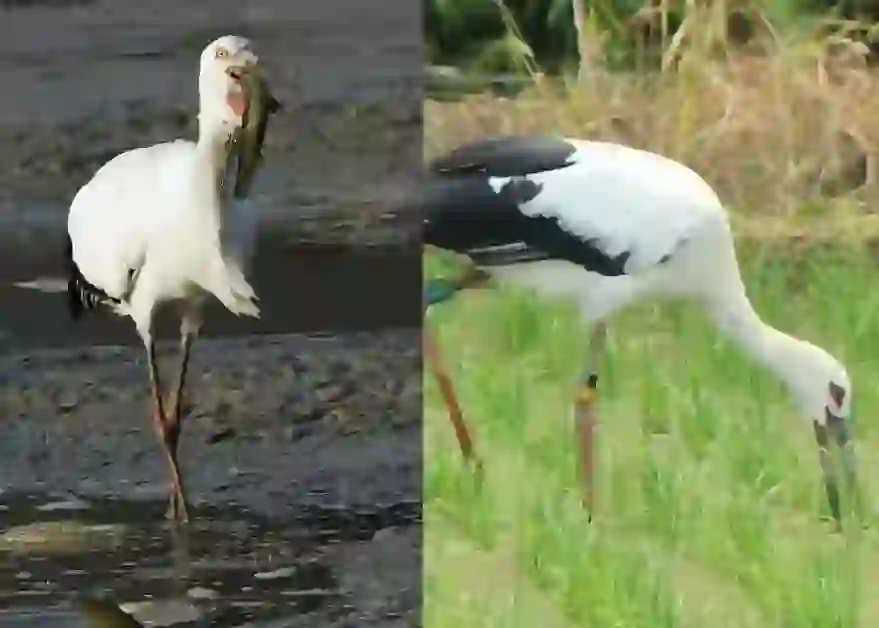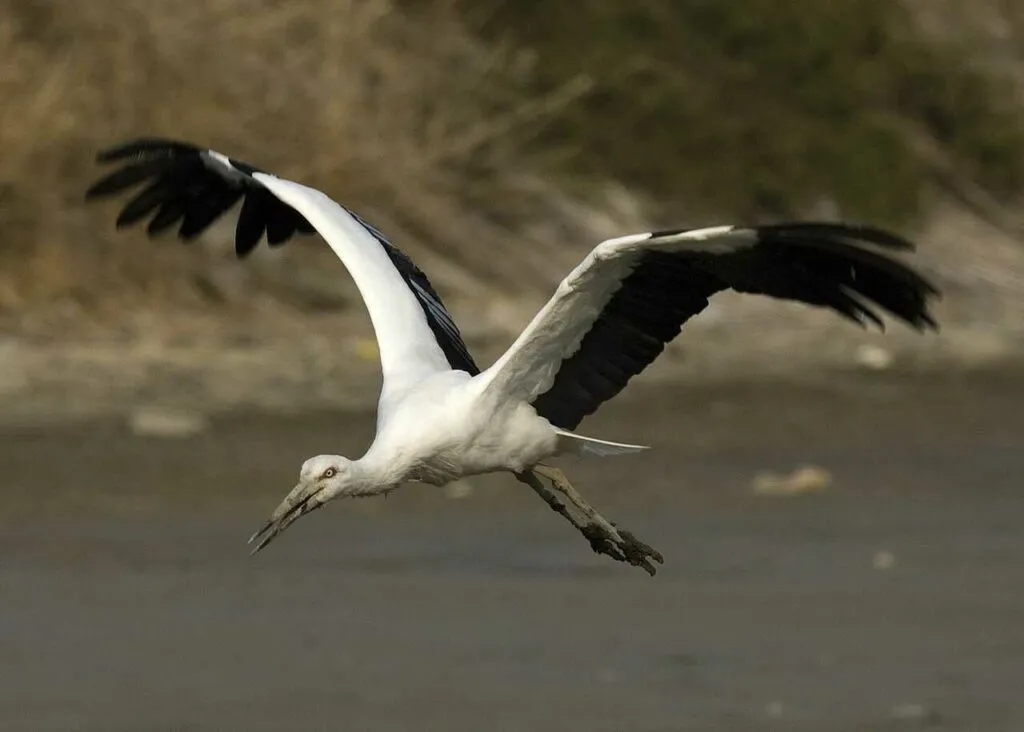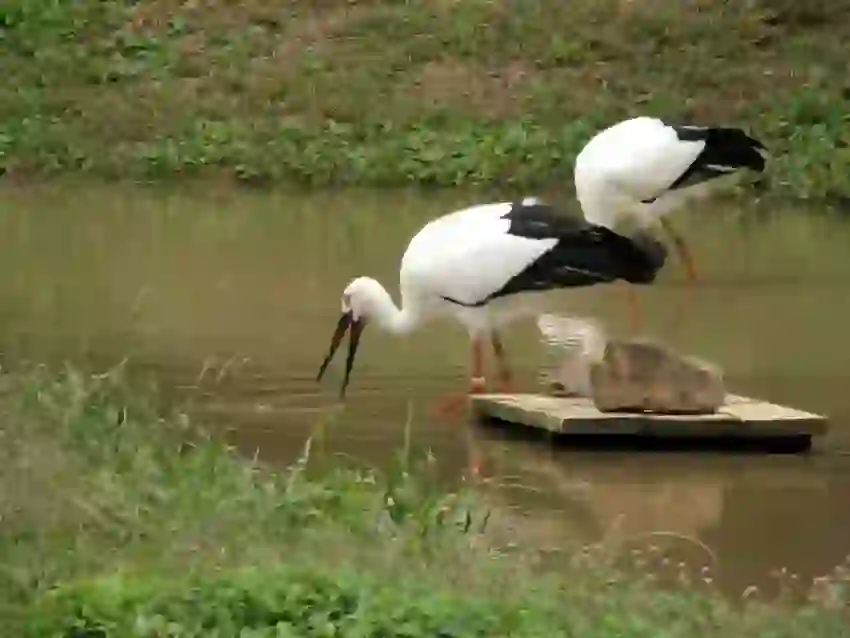
Oriental Stork
Oriental Stork
Oriental Stork
The stork, famously said to bring babies, is actually not the stork in reality. A different bird was mistakenly called a stork, and this mistake became well-known. Let's introduce the true nature of the Oriental Stork.
Oriental Stork Basic Infomation

Class: Aves, Order: Ciconiiformes, Family: Ciconiidae, Genus: Ciconia
Total length: 110-115 cm
Wingspan: 195 cm when wings are spread
Weight: 3-5 kg
The Oriental Stork resides in Korea, China, Taiwan, the Korean Peninsula, Russia, and Japan. It is notably absent from Europe and America, showing a concentrated distribution.
Their body is covered with white feathers, with black tips on their wings. Their beak is black, and the area around their eyes and their legs are red. The contrast of black and red against the white is very striking and makes one want to observe them in real life.
Their feet have four toes, three forward and one backward, allowing them to grasp branches.
Storks do not vocalize as adults due to their physical development not supporting vocal organs to produce sound, although as chicks they cry similarly to other birds.
Oriental Stork Q&A

What is the origin of the name 'stork'?
The stork is written as '鸛' in Chinese and it is said that its name evolved from 'クヮンの鳥' to 'カンノトリ', and then to 'コウノトリ' as it is called today.
Additionally, during the Nara period in Japan, it was called 'おほどり', which later became shortened to 'こう', leading to its current name 'コウノトリ'.
Whether it comes from the Chinese character or just a change in the name over time is uncertain, but it is known that storks have been living close to humans for a long time.

Why do storks live there?
Storks are migratory birds that fly to warmer regions during winter.
They primarily live in wetlands, rice fields, and villages near rivers, and during the breeding season, they build nests in large trees nearby. These nests are made from branches and are lined with soft, dry grass in the center to make it comfortable for the chicks.
They live near water because their food is found there, and the presence of water suggests nearby forests or woods.
Historically, storks built nests on large trees, but in modern Japan, artificial nesting towers are constructed in some areas to facilitate easier nesting for storks.

What do storks eat?
Storks are carnivorous and mainly eat fish such as loaches and catfish, crustaceans, shellfish, frogs, and snakes, and they occasionally eat mice, bird eggs, and chicks.
They consume a large amount of food, eating up to 500 grams per day, which translates to about 70-80 frogs or loaches a day. It's an incredible amount of food, which might be necessary given their large size among birds.

Is the story of storks bringing babies a myth?
As mentioned earlier, the tale of storks bringing babies actually originates from a different bird called the Shoebill, not the stork.
The story itself comes from an old German tradition where a childless couple saw a stork building a nest and having chicks in a tree near their home, which coincided with the couple finally having a child of their own. This led to the sayings 'storks bring babies' and 'a home where storks live will be visited by happiness'.
However, it turns out that the bird thought to be a stork was actually a shoebill because storks do not live in Europe. The two birds look similar, which led to the confusion.
This mix-up of storks with other birds is not limited to Germany.

Is it true that storks were mistaken for cranes?
In fact, not only in Germany but also in Japan, storks were mistaken for another bird. '松上の鶴 (Pine Top Crane)' was a motif used in paintings and Kabuki, which was actually a stork.
Pine Top Crane, as the name suggests, depicts a beautiful crane perched on a pine tree, which is impossible because cranes do not perch or build nests on trees.
On the other hand, storks can perch on trees and often build nests in pine trees, which match the conditions described.
This mix-up of storks with cranes continued in Japan until the early Shōwa period.
Despite being mistaken for various birds, storks are seen as beautiful birds that have touched and saved people's hearts.

How do storks communicate?
As explained at the beginning, adult storks become unable to make sounds as they age, so how do they communicate?
Adult storks engage in a behavior called 'clattering' where they clack their beaks together to make a 'click-clack' sound used for intimidation, courtship, marking territory, or even greeting.
This action involves not just clacking their beaks but arching their heads back to their backs and then clacking their beaks as they bring their heads forward. This dynamic display can be quite overwhelming and impressive.
It would be fascinating to see storks communicating through clattering at least once.

How do stork families spend their time?
Storks are monogamous, so once they choose a partner, they are committed to them for life. Therefore, they are very cautious when selecting a mate and do not court just any opposite-sex individual but only those with whom they want to spend their entire life.
After successful courtship through clattering, they start living together instead of alone, eventually having children.
Together, they build a large nest about 2 meters in diameter, lay 2-6 eggs, and take turns incubating them.
About a month later, the eggs hatch, and the parents bring food for the chicks, which they first ingest and then regurgitate into the nest for the chicks to eat. Unlike other birds where the parent feeds directly into the chicks' mouths, stork chicks feed themselves from what is regurgitated into the nest. It's as if the parents are teaching them that they need to learn to feed themselves soon.
It might seem a bit cold, but the parents are fully committed to protecting their chicks.
For example, on hot days, they spread their wings to create shade, bring water in their mouths to cool them down, or cover them with their wings on rainy days to keep them dry.
Feeding the chicks is challenging as they eat a tremendous amount, twice as much as an adult. As mentioned earlier, adults eat about 500 grams per day, so the chicks eat about 1 kg per day.
By consuming large amounts of food, they grow quickly and are ready to leave the nest about two months after hatching. After leaving the nest, they still receive lessons from their parents on how to fly and hunt before they are fully independent.
The time spent with their parents is only from hatching until they leave the nest, and they do not spend the winter together. Even in this short period, it is evident that they receive ample parental love.

Is it true that storks engage in fierce fights?
While storks have natural predators like snakes and eagles when they are chicks, as adults they virtually have none. Instead, it would not be an exaggeration to say that other storks are their enemies.
Storks are temperamental and aggressive, particularly males, who may engage in fierce territorial fights, sometimes using their beaks to fatally stab their opponents.
Such cases have been reported in China and Japan, indicating a strong will to protect their partners and territories.

Are there legends about storks in Japan?
Storks have various legends in Japan, and some of these are used in the naming of places. Let's introduce a few.
First is 'Kukuhijinja' in Toyooka City, Hyogo Prefecture.
Storks were once called 'kukui'. When Emperor Suinin was with Prince Homutuwake in front of the palace, a stork flew by. Seeing the stork, the prince who was 30 years old but had been unable to speak until then, suddenly spoke, asking, 'What bird is that?' Delighted, the Emperor ordered storks to be captured and presented from either Izumo or Tajima. Storks were revered, and the area where storks lived was called Kukuhijin, and a shrine was built there.
Next is 'Kouhachimangu' in Kurashiki City, Okayama Prefecture.
In ancient times, a large snake appeared at this Hachimangu, terrifying the people. Since storks had built a nest there, the parishioners asked the storks for help. That night, the parishioner's dream showed the tutelary deity who instructed to watch the southeast sky. While puzzled, they watched, and suddenly the shrine shook, and a large snake appeared. The snake climbed to the stork's nest and battled the stork, which eventually defeated the snake. Because the area used to write 'stork' in kanji as '鴻', the place was named 'Kouhachimangu'.
Another is 'Koushrine' in Konosu City, Saitama Prefecture.
In the past, there was a sacred tree cherished by the villagers, but it also caused misfortune if not properly revered, troubling the people. One day, a stork built a nest and laid eggs in this sacred tree. A snake approaching the eggs was fought off by the stork, which successfully drove it away. Strangely, no calamities befell the village thereafter. A shrine was built under that tree, named 'Koushrine', and the region became known as Konosu, named after the stork that built its nest there.
Finally, 'Kounoyu' in Kinosaki Onsen.
A stork with an injured leg soaked its foot in a paddy field and was seen flying away healthily a few days later. Curious, people investigated the spot and discovered hot water bubbling up. This hot water became known as 'Kounoyu'. Kounoyu is renowned as a fountain of youth and happiness. It is also said that a pair of storks came to heal their leg injuries, and it is believed to bring marital harmony.
Storks have many legends, and they are often portrayed as strong, guardian-like figures in these stories. It may not be far from the truth.

Is it true that storks went extinct?
Storks were once a common sight across a wide area in Japan, even nesting on temple roofs in Edo during the 19th century. However, some people disliked storks entering rice paddies for food.
With the spread of hunting guns during the Meiji era, those who disliked storks began to hunt them extensively, leading to a rapid decline in their numbers and pushing them towards extinction.
However, storks still lived in the Tajima area of Hyogo Prefecture and the Wakasa area of Fukui Prefecture. Particularly in Tajima, storks were so cherished due to local legends that they were not hunted.
In 1908, hunting storks was banned, and their habitats were designated as national monuments. This meant not just protecting the storks from hunting but also designating the areas where they still existed as national monuments.
Even this was enough to protect the remaining storks. By 1930, it was estimated that about 100 storks were left.
However, times when they could not be protected eventually came.
During World War II, with a decrease in oil imports, pine oil, extracted from pine trees, was gathered by cutting down these trees. Storks build their nests on pine trees, so they lost their nesting places and could no longer reproduce. The war also led to a shortage of food, and storks were hunted for meat, further reducing their numbers.
After the war, as human settlements were reconstructed and more food was needed, rivers were filled in, eliminating both the storks' habitats and the fish they fed on. Additionally, the use of pesticides in rice paddies killed not only the residing fauna but also the storks that ate them.
Thus, the number of storks dwindled to just 20, and in 1956, the stork itself was designated as a special natural monument.
Efforts were made to capture and breed wild storks to prevent their extinction, but many challenges were faced due to lack of experience in breeding, ingestion of pesticides before capture, and fatal fights among the males.
By 1971, the native Japanese stork had gone extinct.

Is it true that storks have been revived?
Although storks had gone extinct, humans did not give up.
One stork that migrated to Japan was bred in captivity, laying a total of 115 eggs. Although only one chick survived to adulthood, the breeding was successful. This one stork lived for an unusually long 34 years.
Subsequently, storks were obtained from China, and breeding efforts continued. Through persistent breeding, the population reached 100 storks.
In 1999, 'Hyogo Prefectural Homeland for the Oriental White Stork' was opened, and in 2000, 'Toyooka Municipal Museum of the Oriental White Stork' was established. The park focused on the perspective of storks, while the museum considered how storks and humans could develop good relationships from the perspective of local residents.
Around the park, artificial nesting towers were built, and local farmers began cultivating without pesticides, promoting coexistence with storks.
In 2005, storks raised in captivity were released into the wild, and they began to nest. The sight of storks flapping their wings in the sky was a rewarding view for everyone involved in their conservation.
Today, storks continue to be bred, and including wild populations, their numbers have surpassed 300.
The extinction and revival of storks were significantly influenced by human actions, from wars to conservation efforts. Coexisting with animals may be an ongoing challenge for future generations.

Would you like to become a part of the 'Animalbook.jp'?
Turn your knowledge into Q&A and share it with the world. ※Publication will be activated after purchase. Let's share information together!
Oriental Stork Type of List

- Oriental Stork
Information
Congratulations! You are the first commenter!

Create Your Favorite List!
Oriental Stork
Save the animals you love! Build your own list to quickly revisit your favorites later.

Would you like to leave a comment?
※Please note: This is for the purchase of rights to post comments within the article.
Find Your Favorites!
Our shop offers a unique and attractive selection of goods themed around various animals.
Oriental Stork References

- Wikipedia コウノトリ https://ja.wikipedia.org/wiki/コウノトリ
- コウノトリはどんな鳥? https://www.ktr.mlit.go.jp/ktr_content/content/000743648.pdf
- 和歌山市ホームページ http://www.city.wakayama.wakayama.jp/kurashi/bunka_sports/1001119/1009196.html
- サントリーの愛鳥活動 https://www.suntory.co.jp/eco/birds/encyclopedia/detail/1421.html
- 小さな世界都市 豊岡市 https://www.city.toyooka.lg.jp/konotori/aboutkonotori/1004027.html
- 島根県ホームページ https://www.pref.shimane.lg.jp/life/bunka/bunkazai/shimane/tokubetutennnennkinennbutukounotori/
- 美しい水を守る フジクリーン工業株式会社 https://www.fujiclean.co.jp/fujiclean/story/vol59/part203.html
- ちくご・ひらまつ産婦人科医院 https://hiramatsu-lc.com/column/赤ちゃんはコウノトリが運んでくる
- Wikipedia 久久比神社 https://ja.wikipedia.org/wiki/久久比神社
- 日本書紀で伝承、コウノトリ伝説 久久比神社 http://www.happywing.jp/kukuhi.html
- Wikipedia 鴻八幡宮 https://ja.wikipedia.org/wiki/鴻八幡宮#コウノトリ伝説
- 鴻八幡宮ホームページ https://kouhachimangu.net/concept.html
- 鴻神社ホームページ https://www.koujinja.or.jp/legend/
- Wikipedia 鴻神社 https://ja.wikipedia.org/wiki/鴻神社#コウノトリ伝説
- 城崎温泉 きのさき温泉観光協会公式サイト https://kinosaki-spa.gr.jp/about/history/beginning-part1/
- レファレンス協同データベース https://crd.ndl.go.jp/reference/modules/d3ndlcrdentry/index.php?page=ref_view&id=1000141169#:~:text=『日本語源広辞典』ミネルヴァ,とあり。
- 日本の鳥 http://nature1-club.travel.coocan.jp/konotori.htm
Oriental Stork Introduction of media used

出典:https://pixabay.com/images/id-3058712/

出典:https://pixabay.com/images/id-3511683/

similar
出典:https://pixabay.com/images/id-6324674/

出典:https://pixabay.com/images/id-3165459/

出典:https://commons.wikimedia.org/wiki/File:J0097J0110.jpg

出典:https://commons.wikimedia.org/wiki/File:Schwarzschnabelstorch.jpg

other
出典:https://commons.wikimedia.org/wiki/File:Kukuhi-jinja_0383.JPG

other
出典:https://commons.wikimedia.org/wiki/File:Kouhachimangu_haiden.jpg

出典:https://commons.wikimedia.org/wiki/File:J0110_.jpg

出典:https://pixabay.com/images/id-6519599/

Help Enrich Our Animalbook.jp with Your Media!
We are constantly looking to expand and enrich our Animalbook.jp with amazing photos and videos of animals. If you have any media that you'd like to share, please contribute and help us showcase the beauty and diversity of the animal kingdom. Your submissions will be credited and featured in our encyclopedia, reaching a wide audience of animal lovers.




















